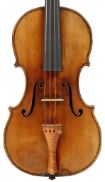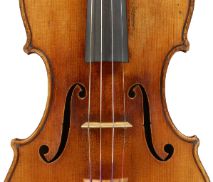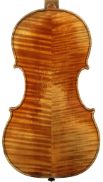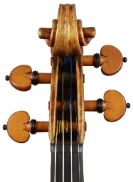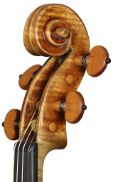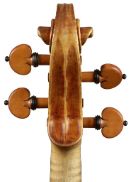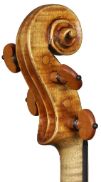Violin, Jean-Baptiste Vuillaume, Paris, 1858, “ex Applebaum”
Printed label: “Jean Baptiste Vuillaume à Paris / Rue Croix des Petit Champs” (two concentric circles, inscribed “B [cross] V”)Jean-Baptiste Vuillaume was the leading maker of string instruments and bows in France and abroad in the mid-19th century. Likewise, he dominated the trade in historical instruments. His profound understanding of Italian instruments allowed him to imitate the Italian masters’ styles consummately. Most of his violins were fashioned on the models of Stradivari and Guarneri del Gesù, but Vuillaume also built instruments featuring the styles of Amati and Maggini. His labels rarely state the year in which an instrument was made on his labels, but Vuillaume used consecutive numbers, which makes it possible to date the instruments. The “ex Applebaum” violin is numbered 2272, indicating that it was built in 1858. Its low arching and especially the cut of the f-holes indicate that it was built on a Guarneri model. The shape of the f-holes strongly recalls those of a 1741 Guarneri del Gesù violin now named after Belgian violinist Henri Vieuxtemps, which was part of Count Cozio di Salabue’s collection in 1804. Vuillaume succeeded in acquiring the instrument in 1858 and ultimately sold it to Henri Vieuxtemps. It is quite possible – as the shape of the f-holes and the pegbox and scroll design suggest – that Vuillaume imitated this Guarneri del Gesù violin with its outstanding tone in making the 1858 instrument. However, the body measurements do not match: Vuillaume’s violin is built on a larger model and is 2 mm longer. Furthermore, the upper and lower bouts are slightly wider. The two-piece belly is made of spruce with medium-wide annual rings. The two halves are not from the same log, and the most recent annual ring was dated 1845. The two-piece back is made of attractive, strongly flamed maple, with the flames fanning out in an open V shape. The ribs and head display tighter flames than the back. The fairly flat arching begins after narrow fluting and has very harmonious curves. Like the f-holes of the del Gesù violin, the soundholes on this instrument are very slender and flamboyant. The very wide edges and the purfling, which Vuillaume deliberately executed with irregularities, are also made in the style of Guarneri del Gesù. The proportions of the pegbox and the deeply undercut volutes bring to mind del Gesù’s late period violins. Vuillaume’s violin is still fit with the original neck, which was reset and repitched to obtain the neck length and angle common today. Vuillaume generally used an intense, reddish varnish, much of which is still intact on the 1858 violin. The varnish profile shows clear signs of wear in the middle of the back plate.
This instrument takes its name from violinist and teacher Samuel Applebaum (1904–1986) from New Jersey, who graduated from the Juilliard Institute of Music. He taught in New York and wrote many textbooks for strings.
Borrower: Laura Gfrerer


